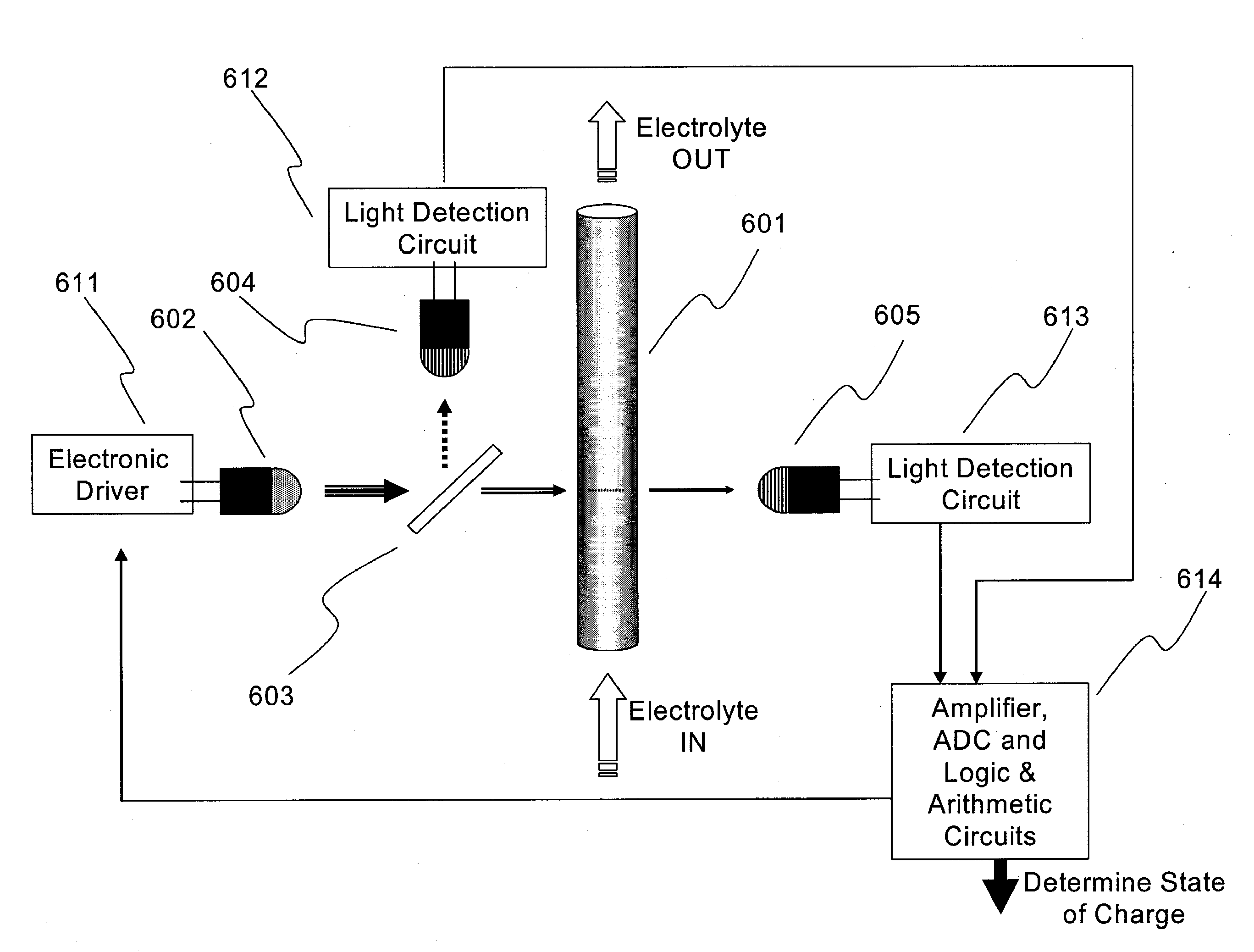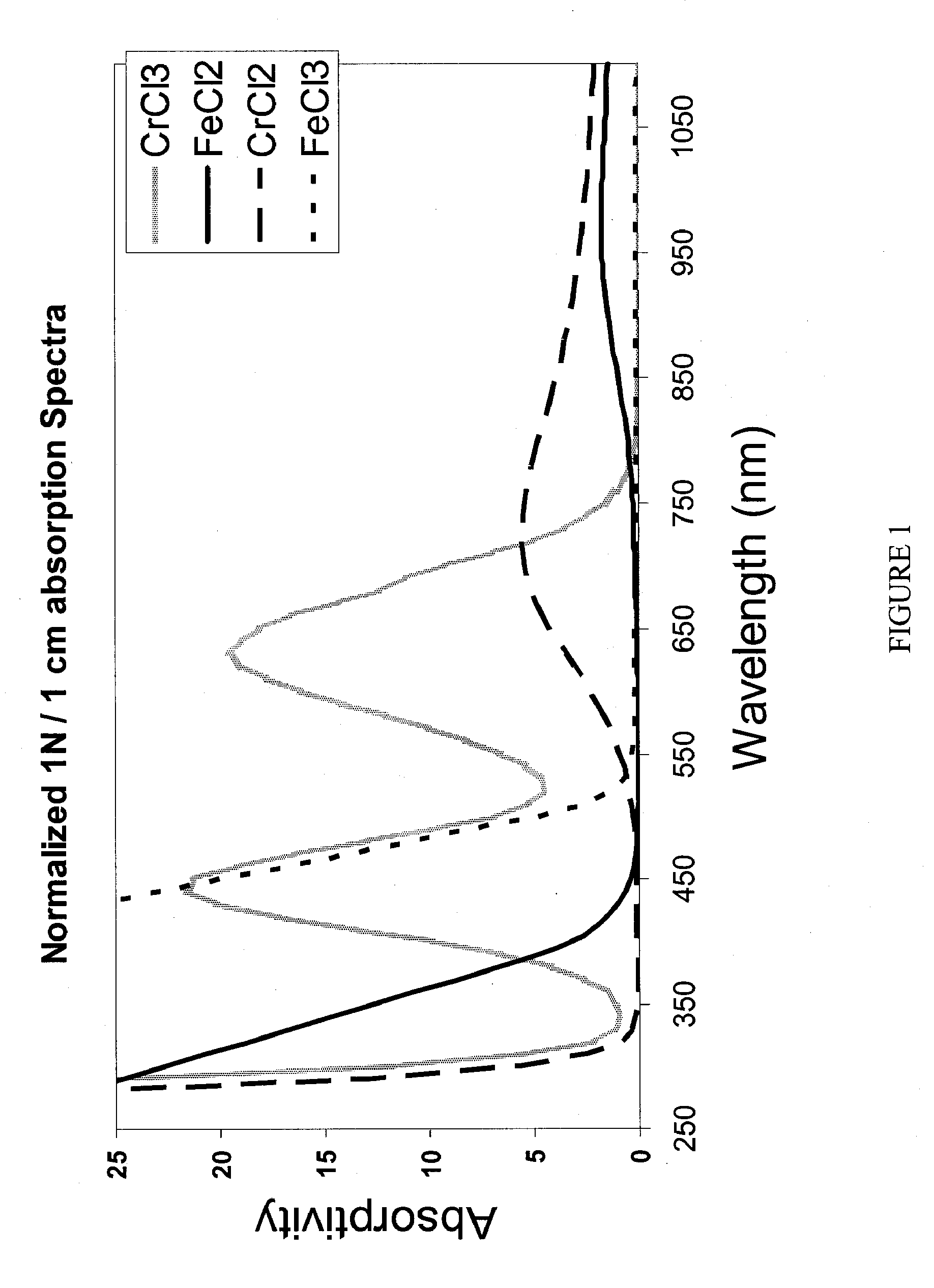Apparatus and Methods of Determination of State of Charge in a Redox Flow Battery
a technology of redox flow and apparatus, applied in the field of measurement, can solve the problems of increasing so as to increase the photometric density of light falling, increase the signal-to-noise ratio of the photometric measurement, and increase the effect of light falling
- Summary
- Abstract
- Description
- Claims
- Application Information
AI Technical Summary
Benefits of technology
Problems solved by technology
Method used
Image
Examples
example 1
Preparation of Correlation Tables (Method 1)
[0124]The absorption spectra of the iron side (Catholyte) of a mixed reactant (FeCl2, FeCl3, CrCl3) half cell were determined for known states of charge / discharge (5% charged, 25% charged, 50% charged, 75% charged and 95% charged) and are shown in FIG. 4. The absorbance at 900 nm for each of the charge states was recorded as shown in the table below, and plotted to form a correlation graph as shown in FIG. 8.
%Catholyte AbsorptivityCharged(900 nm)51.4251.2500.8750.5900.3
The absorption spectra of the chromium side (Anolyte) of a mixed reactant (CrCl3, CrCl2, FeCl2) half cell were determined for known states of charge / discharge (5% charged, 25% charged, 50% charged, 75% charged and 0.95% charged) and are shown in FIG. 5. The absorbance at 650 nm for each of the charge states was recorded as shown in the table below, and plotted to form a correlation graph as shown in FIG. 9.
%ChargedAnolyte Absorptivity (650 nm)51825155011.25757.5905.25
example 2
Preparation of Correlation Tables (Method 2)
[0125]The following solutions are prepared in 1N hydrochloric acid:
Molar conc. of speciesSoln. #CrCl3CrCl2FeCl3FeCl2Corresponds to State of Charge of Electrolyte11M 1MFully charged catholyte21M0.75M0.25M 75% charged (25% discharged) catholyte31M 0.5M0.5M 50% charged (50% discharged) catholyte41M0.25M0.75M 25% charged (75% discharged) catholyte51M1MFully discharged catholyte6 1M1MFully charged anolyte70.25M 0.75M1M75% charged (25% discharged) anolyte80.5M 0.5M1M50% charged (50% discharged) anolyte90.75M 0.25M1M25% charged (75% discharged) anolyte101M1MFully discharged anolyte
Therefore:
[0126]Solution 1 contains CrCl3 (15.84 g, 100 mmol) and FeCl3 (16.22 g, 100 mmol) in HCl (100 mL, 1N);
Solution 2 contains CrCl3 (15.84 g, 100 mmol), FeCl3 (12.165 g, 75 mmol) and FeCl2, (3.17, 25 mmol) in HCl (100 mL, 1N);
Solution 3 contains CrCl3 (15.84 g, 100 mmol), FeCl3 (8.1 μg, 50 mmol) and FeCl2 (6.34 g, 50 mmol) in HCl (100 mL, 1N);
Solution 4 c...
example 3
Determination of State of Charge and State of Charge Balance of a Mixed Reactant (Fe / Cr) Redox Flow Cell
[0127]A mixed reactant redox flow cell is prepared with a CrCl3, CrCl2, FeCl2 chromium side anolyte and a FeCl2, FeCl3, CrCl3 iron side catholyte. The cell is run through five charge—discharge cycles. The absorbance of the anolyte at 650 nm is measured and determined to be 11.2. Using the correlation table in FIG. 9, the anolyte is calculated to be 50% charged (i.e. the state of charge is 50%). The absorbance of the catholyte at 900 nm is measured and determined to be 0.8. Using the correlation table in FIG. 8, the anolyte is calculated to be 50% charged (i.e. the state of charge is 50%). Thus the system is still in a state of charge balance. The cell is next run through an additional twenty charge—discharge cycles. The absorbance of the anolyte at 650 nm is measured and determined to be 11. Using the correlation table in FIG. 9, the anolyte is calculated to be 48% charged. The ab...
PUM
| Property | Measurement | Unit |
|---|---|---|
| Full Width at Half Maximum | aaaaa | aaaaa |
| FWHM | aaaaa | aaaaa |
| optical absorption spectra | aaaaa | aaaaa |
Abstract
Description
Claims
Application Information
 Login to View More
Login to View More - R&D
- Intellectual Property
- Life Sciences
- Materials
- Tech Scout
- Unparalleled Data Quality
- Higher Quality Content
- 60% Fewer Hallucinations
Browse by: Latest US Patents, China's latest patents, Technical Efficacy Thesaurus, Application Domain, Technology Topic, Popular Technical Reports.
© 2025 PatSnap. All rights reserved.Legal|Privacy policy|Modern Slavery Act Transparency Statement|Sitemap|About US| Contact US: help@patsnap.com



